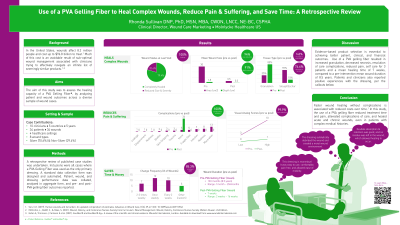Clinical Research
(CR-060) Use of a PVA Gelling Fiber to Heal Complex Wounds, Reduce Pain & Suffering, and Save Time: A Retrospective Review
Friday, April 28, 2023
7:15 PM - 8:30 PM East Coast USA Time

Introduction: In the United States, wounds affect 8.2 million people and cost up to $96.8 billion to treat. Much of this costs is an avoidable result of sub-optimal wound management. The aim of this study was to assess the healing capacity of a PVA Gelling Fiber, by analyzing patient and wound outcomes across a diverse sample of wound cases.
Methods: A retrospective review of published case studies was undertaken. Inclusions were all cases where a PVA Gelling Fiber was used as the only primary dressing. A data collection form was designed and automated. Patient, wound, and dressing performance data was collated, analyzed in aggregate form, and pre- and post-PVA gelling fiber outcomes reported.
Results: Thirty-four wound cases from 10 clinicians, across the care continuum in 5 countries over 5 years were included. Patients ranged from 25 to 96 years old and presented with complex medical histories. Eight wound types were represented. Delayed healing was reported in 85% of the wounds, with a mean duration of 8.5 years.
For all patients, a silver or non-silver PVA gelling fiber was used as a primary dressing and changed based on local protocols. 64.7% of the wounds completely healed (n=22) in an average of 7 weeks. The remaining wounds reduced in size and severity, with a mean area reduction of 95% and depth reduction of 91%. The overall condition of all wounds improved based on a 142% increase in granulation and 74.6% decrease in slough/eschar. Exudate levels for 88% of the wounds reduced to light to none. All complications of care resolved and pain scores reduced to zero.
Discussion: In this study, the use of a PVA gelling fiber reduced treatment time and pain, alleviated complications of care, and healed acute and chronic wounds, even in patients with complex medical histories.
Methods: A retrospective review of published case studies was undertaken. Inclusions were all cases where a PVA Gelling Fiber was used as the only primary dressing. A data collection form was designed and automated. Patient, wound, and dressing performance data was collated, analyzed in aggregate form, and pre- and post-PVA gelling fiber outcomes reported.
Results: Thirty-four wound cases from 10 clinicians, across the care continuum in 5 countries over 5 years were included. Patients ranged from 25 to 96 years old and presented with complex medical histories. Eight wound types were represented. Delayed healing was reported in 85% of the wounds, with a mean duration of 8.5 years.
For all patients, a silver or non-silver PVA gelling fiber was used as a primary dressing and changed based on local protocols. 64.7% of the wounds completely healed (n=22) in an average of 7 weeks. The remaining wounds reduced in size and severity, with a mean area reduction of 95% and depth reduction of 91%. The overall condition of all wounds improved based on a 142% increase in granulation and 74.6% decrease in slough/eschar. Exudate levels for 88% of the wounds reduced to light to none. All complications of care resolved and pain scores reduced to zero.
Discussion: In this study, the use of a PVA gelling fiber reduced treatment time and pain, alleviated complications of care, and healed acute and chronic wounds, even in patients with complex medical histories.

.png)